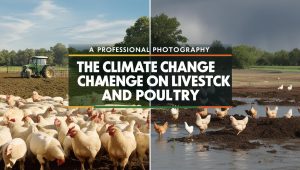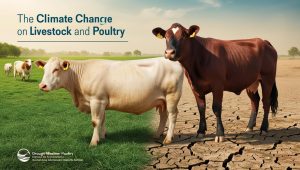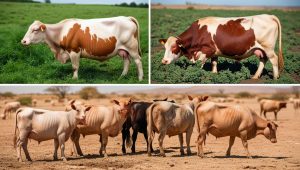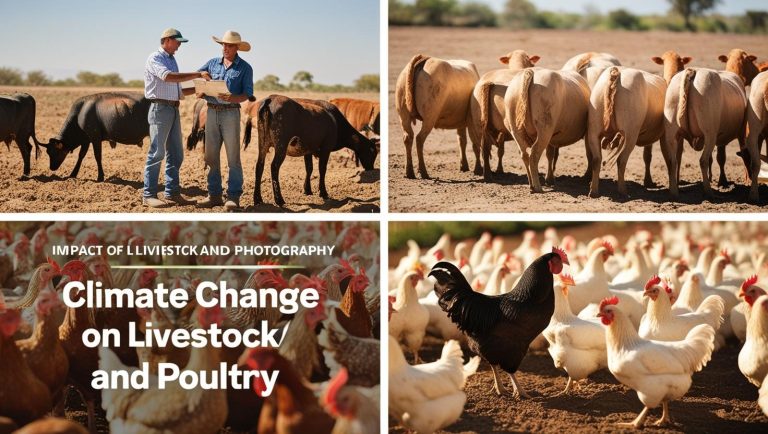Climate change is one of the most pressing challenges facing the global agricultural sector today, with livestock and poultry production being highly vulnerable to its effects. Rising temperatures, unpredictable weather patterns, increased frequency of extreme weather events, and shifts in disease prevalence are all factors that influence the health, productivity, and sustainability of livestock and poultry farming.
This article explores the impact of climate change on livestock and poultry, highlighting the challenges and potential mitigation strategies to ensure sustainable animal agriculture in a changing climate.
Click HERE to join our WhatsApp group
Effects of Climate Change on Livestock and Poultry
a) Heat Stress and Temperature Changes
One of the most direct impacts of climate change is the rise in global temperatures, which leads to heat stress in livestock and poultry.
Effects on Livestock: Reduced feed intake, lower weight gain, decreased fertility, and increased susceptibility to diseases.
Effects on Poultry: Lower egg production, reduced hatchability, and increased mortality rates.
Mitigation Strategies: Providing shade, proper ventilation, cooling systems, and adjusting feeding schedules to cooler parts of the day.
b) Water Scarcity and Quality Issues
Climate change leads to irregular rainfall patterns, causing droughts in some areas and floods in others. This affects water availability and quality for livestock and poultry.
Effects on Animals: Dehydration, lower productivity, and increased susceptibility to diseases.
Mitigation Strategies: Implementing water conservation measures, rainwater harvesting, and providing alternative water sources.
c) Changes in Feed Availability and Nutrition
Climate change affects crop production, leading to feed shortages and increased prices of animal feed.
Effects on Livestock and Poultry: Nutritional deficiencies, poor growth, lower milk and egg production.
Mitigation Strategies: Using climate-resilient feed crops, supplementing animal diets, and exploring alternative feed sources like insects and by-products.
d) Increased Disease Prevalence and Parasitic Infestations
Changing climatic conditions create favorable environments for the spread of infectious diseases and parasites.
Examples: Rift Valley fever, avian influenza, foot-and-mouth disease, and increased tick and mosquito-borne diseases.
Mitigation Strategies: Enhanced disease surveillance, vaccination programs, and improved biosecurity measures.
READ ALSO: Nutritional Needs for Guinea Fowls
e) Extreme Weather Events
Climate change is causing more frequent and intense storms, droughts, and floods, all of which threaten livestock and poultry farming.
Effects: Loss of animals, destruction of infrastructure, and increased economic losses for farmers.
Mitigation Strategies: Developing disaster preparedness plans, investing in resilient infrastructure, and establishing early warning systems.
Adaptation and Mitigation Strategies

a) Climate-Resilient Breeding
Developing heat-tolerant and disease-resistant livestock and poultry breeds can help mitigate climate change impacts.
Examples: Indigenous cattle breeds with heat tolerance and poultry breeds resistant to harsh conditions.
Implementation: Selective breeding, genetic modification, and crossbreeding programs.
b) Sustainable Housing and Farm Management
Improved housing designs: Ventilated poultry houses, shaded livestock shelters, and cooling systems.
Efficient waste management: Utilizing animal waste for biogas production and organic fertilizers.
Rotational grazing: Prevents overgrazing and preserves pasture quality.
c) Sustainable Feed Production
Drought-resistant forage crops: Growing sorghum, millet, and legumes that require less water.
Alternative feed sources: Using crop residues, insects, and agricultural by-products to reduce feed dependency.
READ ALSO: Guinea Fowl Farming: A Profitable Venture
d) Water Conservation Techniques
Rainwater harvesting: Collecting and storing rainwater for use in drought-prone regions.
Efficient irrigation: Using drip irrigation for fodder crops.
Water recycling: Treating and reusing water to minimize wastage.
e) Disease Surveillance and Biosecurity
Regular health monitoring: Early detection of diseases through routine checkups.
Strict biosecurity protocols: Preventing the introduction of pathogens into farms.
Vaccination and preventive treatments: Protecting animals from climate-driven disease outbreaks.
Policy and Government Interventions

Governments and international organizations play a crucial role in mitigating climate change impacts on livestock and poultry farming.
Climate-smart policies: Encouraging sustainable farming practices and funding climate adaptation programs.
Support for farmers: Providing subsidies for climate-resilient breeds, feed, and farm infrastructure.
Research and innovation: Investing in studies on climate adaptation strategies for animal agriculture.
Disaster relief programs: Assisting farmers affected by extreme weather events.
Role of Farmers in Climate Adaptation

Farmers can take proactive steps to reduce climate risks in their livestock and poultry operations:
Adopting sustainable farming techniques: Using renewable energy, rotational grazing, and organic feed production.
Implementing climate monitoring tools: Tracking temperature, humidity, and weather forecasts to plan farm activities.
Collaborating with researchers and extension officers: Learning new techniques for climate-resilient livestock management.
Conclusion
Climate change presents significant challenges to livestock and poultry farming, but with proactive measures, its impact can be minimized. Implementing climate-smart practices, improving biosecurity, using sustainable feed sources, and investing in climate-resilient infrastructure are essential for maintaining productivity and food security. Collaboration between farmers, policymakers, researchers, and stakeholders will be key in ensuring a sustainable and climate-resilient livestock and poultry industry.
READ ALSO: Sheep Farming: Wool, Meat, and Dairy Production
Sheep farming is one of the oldest forms of livestock agriculture, providing essential products such as wool, meat, and dairy to human societies for centuries. This industry plays a significant role in economies worldwide, particularly in regions where sheep are well-adapted to the environment. Successful sheep farming requires proper knowledge of breeds, nutrition, disease management, and production techniques to maximize productivity and sustainability…
READ ALSO: Stress Management in Livestock
Stress in livestock is a significant concern for farmers and animal welfare experts. Stress can negatively impact growth, reproduction, immunity, and overall productivity. It can be caused by various factors, including environmental conditions, handling practices, nutrition, and diseases…
Click HERE to join our WhatsApp group

